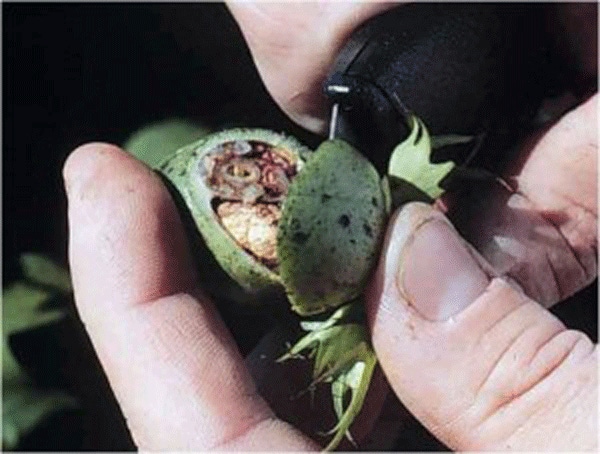April 9, 2013

Although largely determined by weather patterns, our predictive capabilities for insect outbreaks, like weather, are poor more than a week or two in advance.
However a few observations may be in order as we approach planting.
Thrips have consistently caused major headaches for North Carolina’s and Virginia’s cotton producers, particularly in early planted cotton.
The North Carolina/Virginia region leads the Southeast and other parts of the Cotton Belt in high thrips levels and potential damage.
Our slow seedling grow-off conditions (extending the period of seedling susceptibility to thrips damage) and high amount of surrounding thrips host vegetation that serve to funnel thrips adults into relatively small cotton fields often result in a rough start for cotton seedlings.
Even though hot, dry spring weather may result in quicker grow-off conditions and a narrower window of thrips vulnerability for cotton seedlings, the rapid drying of alternative thrips hosts (weed hosts, wheat, etc.) helps create high levels of migrating adult thrips.
Dry soil may also limit the uptake of seed treatment insecticides and at-planting foliar insecticides.
Unfortunately, thrips headaches are more often the rule than the exception for most North Carolina cotton producers.
Following the seed treatments Aeris/Poncho/VOTiVO, Avicta Complete or Acceleron, unless cotton is scouted religiously every 5 days, a foliar spray targeted at the first true leaf stage or at 3 weeks after planting (whichever comes first) is often the rule here in the Upper Southeast.
However, if cotton is planted after about May 20, the typically faster grow-off conditions often mean that a seed treatment alone may control thrips.
At our latitude and throughout most of the Southeast, plant bug damage is usually surprisingly low during the pre-bloom period and beyond.
Plant bugs on the increase
However, plant bug levels have increased in the past few years. Although we had averaged treating 6.3 percent of our consultants’ clients’ acreage for plant bugs from 2004 until 2007, an average of 16.3 percent was treated in 2011-12.
Is this a trend?
As a general rule, a warm winter with adequate moisture will favor the early development of weeds and other host vegetation and increase plant bug populations, resulting in higher levels moving into cotton when these hosts begin to dry down.
(You might also be interested in Consultant survey offers realistic look into North Carolina insect picture).
In North Carolina, whether generally favored by more generous early season rainfall or additional suitable hosts, plant bug levels are typically higher in our eastern counties.
The potential for stink bug damageappears to have a strong correlation with moisture throughout the bloom period, with dry years often resulting in low stink bug damage to the less attractive and less susceptible cotton plants.
However, late sub-freezing weather following a warm winter when brown and green stink bugs are active, though not common, can have a devastating impact on their levels and potential damage. This was the case in 2007 when a hard Easter Freeze reduced stink bugs to sub-economic levels for the entire growing season in most areas of the state.
Dry weather also negatively influences early wild and cultivated stink bug hosts resulting in fewer stink bugs and damage. As a general rule, higher moisture levels are correlated with higher stink bug levels and boll damage, but also higher cotton yields in our dryland region.
Successful corn earworm (cotton bollworm) moth emergence from the soil, primarily in May here, is influenced both by the number and quality of bollworms going into the soil in the fall and their over-wintering pupal mortality which in turn is influenced winter weather and its impact on pupal cell integrity in the ground.
In general, wetter winters result in higher bollworm pupal mortality.
However, bollworms undergo two generations, first on whorl stage and then ear stage corn, before invading cotton and most other agronomic crops.
The corn earworm generation that feeds on field corn ears can account for significant buildups in the subsequent generation.
On the practical side, bollworm damage to cotton has been low since the introduction of 2-gene Bt cotton in 2006.
Our highest damage levels often result from a combination of one or more of the following factors: late cotton planting, wet conditions favoring rank cotton growth, a disruptive foliar spray(s) for stink bugs, and a large late bollworm moth flight.
In recent years, as a result of the introduction of BGII and WideStrike cotton, our producers experienced only minimal damage from other caterpillars, such as fall and beet armyworms, European corn borers, and soybean loopers.
Unlike conventional and Bollgard cotton, Bollgard II and Widestrike varieties show high resistance to both armyworm species and loopers.
The early appearance and high abundance of migratory species such as loopers and beet and fall armyworms at our latitude is very much favored by hot dry spring and summer conditions.
You might also like:
South Carolina peanut growers prepare to plant as acreage questions loom
Urea over-supply forecast post 2015
Small grains research yields economic benefit for farmers, Virginia Tech
Hog profits may still return due to lower feed costs
You May Also Like




